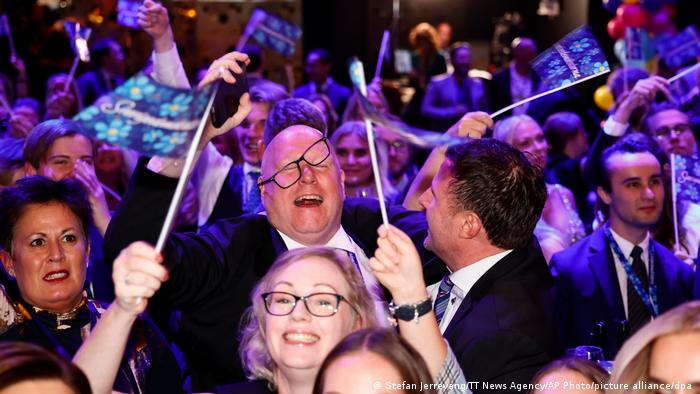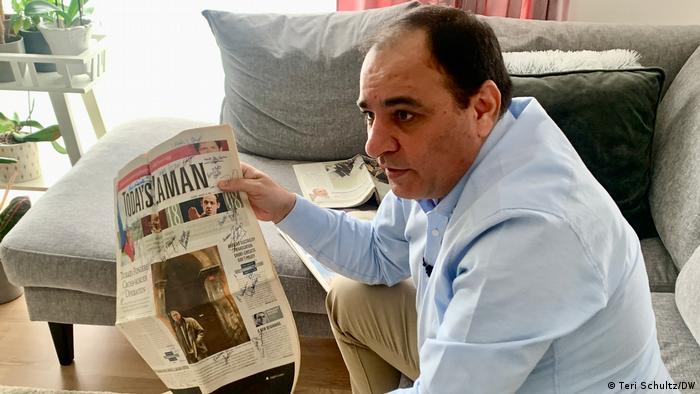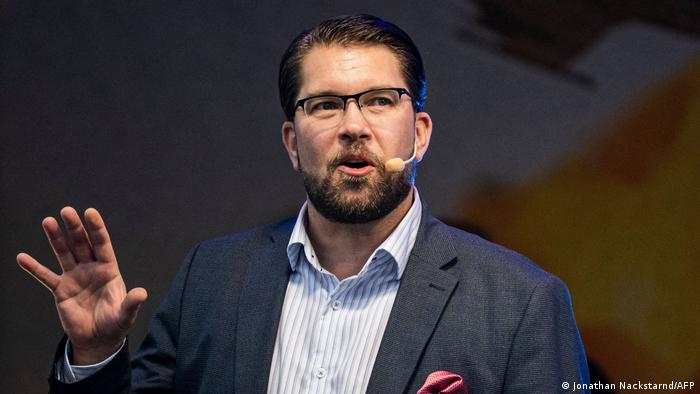Issued on: 14/09/2022
Text by: NEWS WIRES|
Video by: FRANCE 24
Swedish Prime Minister Magdalena Andersson on Wednesday announced that she would resign after an unprecedented right-wing and far-right bloc narrowly won Sunday's election.
Out of the Swedish parliament's 349 seats, the right-wing opposition was set to win 176, thanks in part to a surge by far-right Sweden Democrats (SD), with over 99 percent of districts counted. Speaking at a press conference, Andersson, Social Democrats party leader, noted that it was a "narrow majority, but a majority nonetheless.
"So tomorrow I will hand in my resignation as prime minister, and the responsibility for the continued process will go to the speaker," Andersson said.
Sunday's elections were so close that tens of thousands of votes from abroad and those cast in advance had to be counted to validate the results.
'Making Sweden great again'
Never before has a Swedish government relied on the support of the anti-immigration and nationalist SD, who became the big winners of the vote, by gaining more than three percentage points.
With 20.6 percent of votes counted so far the party emerged as Sweden's second largest party behind the Social Democrats, which have dominated Swedish politics since the 1930s.
However, the post of Prime Minister will in all likelihood go to the leader of the Moderate Party, Ulf Kristersson, as SD leader Jimmie Akesson is unable to unite all four parties to head the government.
"I now begin the work of forming a new and strong government," Kristersson said in a video posted to Facebook. Kristersson, a former gymnast, led a major U-turn for his party when initiating exploratory talks in 2019 with the Sweden Democrats and then deepening their cooperation. The Christian Democrats, and to a lesser extent the Liberals, later followed suit.
At the same time the thorny question remains of whether the far-right would be given cabinet posts, which Akesson said late Sunday was their "goal". In a post to Facebook on Wednesday, Akesson thanked "friends of Sweden", around the country. "Now the work begins of making Sweden great again," the party leader said.
The Sweden Democrats rose up out of neo-Nazi groups and the "Keep Sweden Swedish" movement in the early 1990s, entering parliament in 2010 with 5.7 percent of votes.
Difficult situation
Long shunned as "pariahs" on the political scene, the party has registered strong growth in each subsequent election as it made efforts to clean up its image. Its hardline stance on soaring gang shootings and integration set the tone in this year's election.
The narrow majority also means a right-wing government's hold on power would be very fragile, with the four parties fiercely opposed on a number of issues, especially the Liberals and Sweden Democrats. "This is a difficult parliamentary situation", Gothenburg University political scientist Mikael Gilljam told AFP. "And then you have parties that don't like each other, the Sweden Democrats and the Liberals" in the same right-wing bloc, he added.
In such a situation, a few disgruntled MPs could end up flipping the balance of power. Behind the SD with 73 seats, 11 more than in the last elections in 2018, the Moderates have 68 seats (-2), while the Christian Democrats have 19 (-3) and the Liberals 16 (-4).
On the left, the Social Democrats climbed to 107 seats (+7) thanks to the managing to get 30.4 percent of the vote, ahead of the Left and Centre party (24 seats each) and the Green Party (18).
Formally, the process of political changeover can only start after the announcement of Prime Minister Andersson's resignation on Thursday.
Then the speaker of the Riksdag, the Swedish Parliament, can give Ulf Kristersson the task of forming a majority between the four parties, opening a period of negotiations. The election of the new head of government cannot take place before September 27 at the earliest, when parliament re-opens.
(AFP)
Sweden's far right makes strong gains in cliffhanger election
Marc PREEL
Sat, 10 September 2022

Sweden on Monday began a days-long wait for the final results of its too-close-to-call general election, with an unprecedented right-wing and far-right bloc in position to wrest power from Prime Minister Magdalena Andersson's Social Democrats.
The Scandinavian country has seen mounting political instability in recent years as the gradual rise of the far-right has upset the traditional balance of power in parliament.
Sweden again found itself in a delicate parliamentary situation after Sunday's legislative election, with the right-wing seen holding a razor-thin lead over Andersson's outgoing left bloc.
"The close result in parliament suggests Sweden is heading for yet another messy mandate", newspaper of reference Dagens Nyheter wrote on Monday.
With the vote deemed too close to call, election authorities said a final result would only be ready on Wednesday, when the last ballots from abroad and from advance voting had been counted.
Editorialist Anders Lindberg of daily Aftonbladet said it appeared "impossible for the left to win because the votes from abroad are... usually in favour of the right".

With 95 percent of votes counted on Monday, the right-wing led by conservative Moderates leader Ulf Kristersson was credited with an absolute majority of 175 of 349 seats in parliament.
Andersson's left bloc trailed with 174.
If confirmed, the Social Democrats would be out after eight years in power.
Kristersson, who vowed during the campaign to crack down on law and order amid soaring crime rates, said late Sunday he was "ready to build a new and strong government" if the results were confirmed.
- Far-right gains -
The election's big winner was, however, the anti-immigration, nationalist Sweden Democrats party, led by Jimmie Akesson.
It was credited with 20.7 percent of votes, making it the biggest party on the right and the second biggest in the country behind the Social Democrats.
"It's looking pretty damn good now", 43-year-old Akesson told cheering supporters late Sunday.
The right bloc -- made up of the Sweden Democrats, Moderates, Christian Democrats and Liberals -- were seen winning 49.8 percent of votes.
The left, comprised of the Social Democrats, the Left, the Greens and the Centre parties, were meanwhile credited with 48.8 percent, trailing by around 47,000 votes out of 7.8 million eligible voters.
Prime Minister Andersson, 55, has refused to throw in the towel just yet.

"We're not going to have a final result tonight", she told supporters late Sunday as her party was seen posting a strong result of around 30 percent of votes.
She called on Swedes to "have patience" and "let democracy run its course".
The election marked a major shift in Swedish politics.
For the first time, the Moderates, Christian Democrats and Liberals tied up with the far-right, long treated as "pariahs" by other political parties.
Kristersson orchestrated the change, initiating exploratory talks in 2019 with the Sweden Democrats and then deepening their cooperation.
The Christian Democrats, and to a lesser extent the Liberals, later followed suit.
"Our goal is to sit in government. Our goal is a majority government," Akesson said late Sunday.
- Tensions on the right -
The right-wing bloc is, however, rife with internal divisions, and Kristersson could struggle to form a stable coalition government.
The Liberals have opposed the idea of the Sweden Democrats being given cabinet posts, and would prefer for them to remain in the background providing informal support in parliament.
Akesson has previously insisted his party sit in government, or else he will present a long list of costly demands in exchange for his support.
That could be too much for the Liberals to stomach.
"It would suffice for one of the Liberal party's far-right-critical MPs to dissent for Ulf Kristersson's government to find itself in serious trouble," Dagens Nyheter wrote on Monday.
Political analyst Ulf Bjereld agreed.
A Kristersson-led government "will have to deal with very strong internal tensions and some Liberals will demand that they start to cooperate with the Social Democrats instead", he told AFP.
The Sweden Democrats "have their roots in neo-Nazism and on the other side the Liberals stand for everything the Sweden Democrats don't," he added.
Analysts stressed Sweden was in need of political stability amid a busy docket in the coming months.
The country faces a looming economic crisis, is in the midst of a historic and delicate NATO application process and is due to take over the EU presidency in 2023.
map-aco-po/jv
Sweden's election: The astonishing rise of the right-wing Sweden Democrats
In an election sweep that came as a shock to some, the right-wing Sweden Democrats are now poised to be part of the governing coalition. But who are they and what do they stand for?

The Sweden Democrats gained an unprecedented number of votes this past election
As Europe awaits Swedish election results that balance on a knife's edge, some are asking: How did this happen?
In Sweden, a bastion of tolerance, a nationalist and anti-immigrant party is on the cusp of joining a right-wing coalition in government rule.
A look at the party's origins and trajectory provides some answers.
What is the current state of election results?
On Sunday, Sweden held nationwide elections for its legislature, the Riksdag.
With more than 95% of the vote counted, a winner has not yet been declared.
Exit polls Sunday night initially indicated victory for the Social Democrats' center-left coalition, which has been in power since 2014.
But as vote-counting progressed, the right-wing bloc consisting of the Liberals, Christian Democrats, Moderates and Sweden Democrats now seems on track to win, currently with 49.7% of the vote.
While final results aren't expected before Wednesday, Social Democrats have so far received the largest percentage of votes, 30.5%.
But currently, the Sweden Democrats are the second-strongest party, gaining 20.6% of the vote in their best-ever election performance. That makes them the biggest party on the right, in front of the Moderates who came as a close third with 19.1%.
The cliffhanger election is not expected to be resolved until all postal and absentee ballots are counted.
What is the origin of the Sweden Democrats?
Founded in 1988, the Sweden Democrats unified various elements in Sweden's far-right milieu, including fascists and white power proponents. "Some of them also had ties to openly neo-Nazi movements," said Johan Martinsson, a political science professor at Sweden's University of Gothenburg.
Around the mid-90s, however, new party leadership publicly denounced Nazism.
"Gradually, the party began to normalize and ban outright racism," explained Martinsson, who has written an extensive paper on the party. Openly extremist members were ejected, and its platform reshaped.
But according to Bulent Kenes, a persecuted former editor of a Turkish newspaper who has been living in Sweden since seeking asylum since 2016, "They keep a hidden agenda." He believes the party merely put a compassionate face on its neo-Nazi ideology in order to make it more socially acceptable.
A fresh face in party leadership
In 2005, current party leader Jimmie Akesson came to head the group. Only 26 at the time, the former member of the Moderate party pushed the Sweden Democrat's image away from its far-right roots, taking it in more of a populist direction.
Paralleling other right-populist movements, the party sought to portray itself as "advocating for 'ordinary people' against a corrupt elite at the height of a global recession," wrote scholar Danielle Lee Tomson in a paper on the rise of the Sweden Democrats.

The old logo of the Sweden Democrats conveys a sense of righteousness
As part of its push to project a gentler image, the party's logo was also changed: from the Swedish flag embodied as a flaming torch to the pennywort flower in flag colors of yellow and blue.

The new Sweden Democrats logo has a much softer feel
The party made its debut in the Riksdag in 2010 when it gained almost 6% of the vote.
But it struggled to gain traction and was considered a pariah in coalition-building.
That changed after the migration crisis of 2015.
Sweden Democrats go mainstream
Due largely to the civil war in Syria, Europe was faced with a wave of largely Muslim refugees in 2015. Over the course of one year, 1.3 million people fled to Europe; Sweden took in some 163,000 asylum-seekers (Germany took in around 1 million).
Sweden that year saw the second-highest number of asylum applications per capita in Europe, after Hungary.
Political scientist Martinsson sees this as a major factor in the party gaining traction.
"The main reason for the party's success in the last decade has been Sweden's uniquely high number of asylum-seekers and unusually rapidly changing demographics in terms of ethnicity and the share of foreign-born citizens," he told DW in an interview from Gothenburg.
With immigration as a top topic in both the 2014 and 2018 elections in Sweden, the Sweden Democrats capitalized on this concern.
Turkish journalist Kenes, who has extensively profiled the party, said its defense of "Swedishness" brings results.
"Especially undereducated people feel a threat from the cheap labor of immigrants," he said. "They think [the governing] Social Democrats are not representing their interests anymore."
Increasingly visible criminal violence and gang activity are also playing a role in the rise of the Sweden Democrats.
The party more than doubled its position in the 2014 election, gaining around 13% of votes. In 2018, that share became 18%.
When the center-right Moderates agreed to cooperate with the Sweden Democrats in 2019, this set the stage for eventual entrance to governing.
Caught off guard by current surge
"It is surprising for me to see them as the second-biggest party in the elections," Kenes told DW, as the Sweden Democrats had lost ground during the pandemic as voters turned more toward established parties.

Kenes fled to Sweden after being placed on a list of 'terror suspects' in Turkey
Speaking from Stockholm, he said that aside from the immigration issue, the economic effects of COVID-19 and Russia's invasion of Ukraine have played a part in boosting the party's popularity, particularly among the working class.
He doesn't believe that all Sweden Democrat voters share the party's nationalist ideology but are rather "reacting to inflation and economic deterioration."
What do the Sweden Democrats stand for?
As for political scientist Martinsson, he defines the Sweden Democrats as "mainly an anti-immigration party with a nationalist ideology" but shies away from describing it as extreme- or radical-right.
"In economic terms, the party is more centrist and pragmatic, with a mixture of left- and right-wing proposals," Martinsson said.
Journalist Kenes, however, remains convinced that the party is a threat to democracy.
He points to a recent review indicating that 214 Sweden Democrat candidates who stood in the latest elections can be linked to right-wing extremism.
The Sweden Democrats aim for zero asylum-seekers, along with longer prison sentences and wider use of deportation. The party also has a euroskeptic stance.

Akesson has become the modern face of the Sweden Democrats
"Sweden has been a great country, a safe country, a successful country — and it can be all these things again," Politico reported Akesson as saying during a rally in Helsingborg earlier this month.
"It's time to give us a chance to make Sweden great again," he was quoted as saying.
Edited by: Kate Hairsine
No comments:
Post a Comment